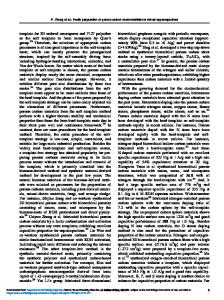One-step preparation of 3D binder-free electrode of porous Co-Mo-S nanostructures grown on Ni foam for supercapacitors
- PDF / 1,714,506 Bytes
- 11 Pages / 595.276 x 790.866 pts Page_size
- 103 Downloads / 441 Views
One-step preparation of 3D binder-free electrode of porous Co-Mo-S nanostructures grown on Ni foam for supercapacitors Nguyen Van Hoa1,* 1 2
, Pham Anh Dat1, and Nguyen Huu Nghia2
Department of Chemical Engineering, Nha Trang University, 2 Nguyen Dinh Chieu, Nha Trang, Vietnam Faculty of Mechanical Engineering, Nha Trang University, 2 Nguyen Dinh Chieu, Nha Trang, Vietnam
Received: 14 August 2020
ABSTRACT
Accepted: 17 November 2020
Transition metal chalcogenides have wide studied as active electrode materials for electrochemical storage devices. In this study, we successfully fabricated a binder-free electrode of hierarchical Co-Mo-S nanosheets on nickel foam (CMS/ NF) by a facile hydrothermal method under microwave irradiation. The CMS layer, with a thickness of a few nanometers, was decorated on the NF’s surface. Taking advantage of the large specific surface area of NF and the high capacitance and porosity of CMS, the prepared electrode is believed to have a rapid electron and ion transport, large electroactive sites, and excellent cycle stability. The specific capacitance of 1080 F g-1 at 1 A g-1 and excellent cycling stability (90.4% retention in specific capacitance after 5000 cycles) were obtained. For further practical applications, an asymmetric supercapacitor was assembled using the CMS/NF as the cathode and the activated carbon as anode material. The prepared device exhibited a high capacitance of 47 F g-1 at 1 A g-1 and a high energy density of 42.6 Wh kg-1 at a power density of 850.3 W kg-1 at a wide operating voltage of 1.6 V. This current method could provide a rapid onestep process for other 3D porous electrodes for high-performance supercapacitors.
Ó
Springer Science+Business
Media, LLC, part of Springer Nature 2020
Handling Editor: Kevin Jones.
Address correspondence to E-mail: [email protected]
https://doi.org/10.1007/s10853-020-05591-6
J Mater Sci
GRAPHICAL ABSTRACT
Introduction Electrochemical capacitors (ECs) or supercapacitors have rapidly developed for the energy industry because of their high power density, quick charge– discharge, excellent long life cycle, and ability to integrate with various energy conversion devices [1–3]. However, their inherent weakness of relatively low energy density and high production cost limited their practical applications [4]. Therefore, there is a need to develop alternative materials with high energy storage and low cost for ECs. Recently, transition metal dichalcogenides (TMDs), comprised of transition metals and chalcogens (S, Se, Te), are widely investigated as active electrode materials in ECs because of their large surface area, multiple redox reactions, and low cost. These excellent properties enable TMDs to store both charges electrostatically (electrical double-layer mechanism) and ion intercalation into interlayer space (Faradaic mechanism), leading to high specific capacitance and energy density [5, 6]. Besides, TMDs exhibit higher electrical conductivity than their oxide counterparts, resulting in improvement in high power capabili
Data Loading...











